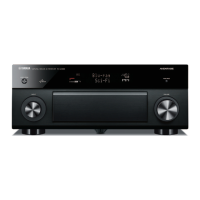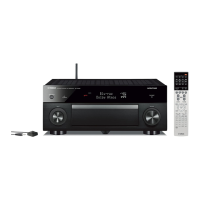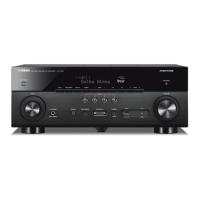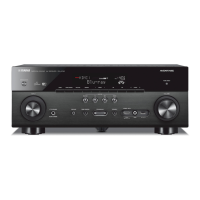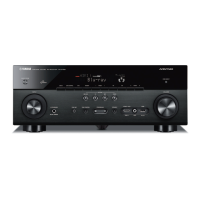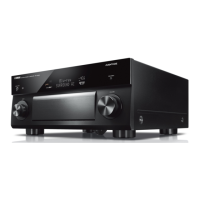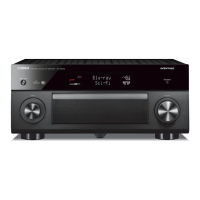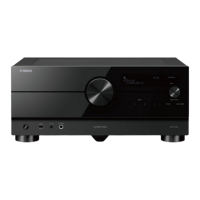Do you have a question about the Yamaha AVENTAGE RX-A1060 and is the answer not in the manual?
Lists all supplied accessories included with the product.
Provides general information and notes about the manual's content and illustrations.
Explains how to use the supplied remote control and its operating range.
Overview of the unit's various useful features and capabilities.
Detailed explanation of the unit's front panel, display, rear panel, and remote control.
Describes helpful applications for unit control and setup.
Guide on connecting speakers to the AV receiver for optimal audio setup.
Instructions for connecting external audio and video devices to the unit.
Steps for connecting FM and AM antennas for radio reception.
Guide on establishing a network connection for internet and streaming services.
Information on connecting devices with trigger functions.
Procedure for connecting the power cable and setting the voltage selector.
How to choose the desired on-screen menu display language.
Manual configuration of speaker settings before automatic optimization.
Using YPAO to automatically detect and optimize speaker connections and acoustics.
Steps for connecting the unit to a wireless network or mobile device.
Guide to adding the unit to the MusicCast wireless multi-room audio network.
Diagram showing the recommended placement for speakers in a surround sound system.
Explanation of the role and function of each speaker type in a system.
Guidance on placing and connecting speakers for various system configurations.
Representative examples of speaker layouts for different channel configurations.
Important safety precautions to prevent short circuits and damage when connecting speaker cables.
Connects digital video and sound through a single jack using an HDMI cable.
Transmits video signals separated into three components: luminance, blue, and red.
Transmits analog video signals using a video pin cable.
Transmits digital audio signals using a digital optical cable.
Transmits digital audio signals using a digital coaxial cable.
Transmits analog stereo audio signals using a stereo pin cable.
Connecting the TV to the unit using an HDMI cable for optimal video and audio.
Connecting the TV using component or composite video cables.
Connecting video devices via HDMI for high-quality video and audio transmission.
Connecting HDMI-compatible devices to the front panel HDMI IN jack.
Connecting devices to the front panel VIDEO AUX and stereo jacks.
Instructions for assembling the AM antenna.
Guide on connecting the unit to a router using an Ethernet cable.
How to position the wireless antenna for optimal reception.
How to connect devices that support the trigger function for synchronized operation.
Important step to set the VOLTAGE SELECTOR before connecting the power cable.
Step-by-step guide for YPAO measurement with a single listening position.
Step-by-step guide for YPAO measurement at multiple listening positions.
How to review the results of the YPAO speaker optimization process.
Procedure to revert to previously saved YPAO speaker settings.
Troubleshooting guide for error messages encountered during YPAO measurement.
Explains potential warning messages during YPAO and how to address them.
How to choose the appropriate network connection method (router or direct).
Instructions for connecting the unit to a wireless router for network access.
Guide to connecting a mobile device directly to the unit via Wireless Direct.
Easily set up wireless connection using iOS device settings.
Procedure to add the unit to the MusicCast wireless network.
Fundamental steps to operate the unit for playback of audio sources.
How to choose which HDMI OUT jack to use for video/audio output.
How to select scenes using the on-screen menu.
How to select sound programs optimized for movie viewing.
How to select sound programs optimized for music listening.
Choosing a decoder for unprocessed multichannel playback from 2-channel sources.
Enabling straight decode for unprocessed sounds in original channels.
Activating Pure Direct mode for minimal circuitry and Hi-Fi sound.
Enhancing compressed music with additional depth and breadth.
Sound programs optimized for video sources like movies, TV, and games.
Enabling straight decode for stereo or unprocessed multichannel playback.
Using surround decoders for unprocessed multichannel playback.
Adjusting FM/AM tuning frequency step settings for regional compatibility.
Procedure to select specific radio frequencies using TUNING or numeric keys.
Establishing a Bluetooth connection to play music from a device.
Step-by-step guide to connect a USB device to the unit's USB jack.
Operating USB storage device contents and starting playback via the TV screen menu.
Configuring media sharing settings on PCs with Windows Media Player or other DLNA software.
Steps to select and play internet radio stations via the NET input.
Procedure to play iTunes/iPod music on the unit via AirPlay.
Examples of how to configure multi-zone setups for music and video.
Playing music in a second room using speakers.
Watching videos or listening to music in another room using a TV.
Connecting speakers to play audio in Zone2, detailing internal amplifier and external amplifier methods.
Steps to select and register a song or radio station to a shortcut number.
How to recall registered items by entering their shortcut number.
Cycling through information items displayed on the front panel.
Displaying status information on the TV screen.
Lists available settings within the Option menu, categorized by function.
Changing input source names and icons for easier identification.
Changing SCENE function settings for customized one-touch control.
Changing settings for sound programs and surround decoders via the TV screen.
Accessing and configuring various unit functions through the Setup menu.
Setting the time for automatic standby mode when the unit is not in use.
Enabling the power-saving ECO mode to reduce unit consumption.
Saving and switching between two different speaker setting patterns.
Copying setting parameters between Pattern1 and Pattern2.
Selecting the speaker system configuration based on connected speakers and amplifiers.
Configuring the size of the front speakers.
Selecting whether a center speaker is connected and its size.
Selecting whether surround speakers are connected and their sizes.
Selecting whether surround back speakers are connected and their sizes.
Selecting speaker layouts for surround speakers.
Selecting speaker layouts for front presence speakers.
Adjusting video and audio delay for synchronization.
Selecting dynamic range adjustment methods for bitstream audio playback.
Setting the maximum volume limit for the unit.
Selecting the output resolution for HDMI video signals when processing is enabled.
Selecting the aspect ratio for HDMI video signals when processing is enabled.
Enabling/disabling HDMI Control for device operation and synchronization.
Enabling/disabling Audio Return Channel (ARC) for TV audio input.
Linking TV and unit standby behavior via HDMI Control.
Selecting the device for audio output (speakers, headphones, or HDMI).
Selecting the method to connect the unit to a network (Wired, Wi-Fi, Wireless Direct).
Configuring network parameters like IP address and DHCP settings.
Enabling or disabling the Bluetooth function for wireless audio streaming.
Configuring Bluetooth settings for the unit as an audio receiver.
Enabling/disabling the unit's power-on function from Bluetooth devices.
Configuring the main zone name displayed on the front panel or TV screen.
Assigning component video, coaxial, and optical jacks to different input sources.
Configuring front display brightness, short messages, and wallpaper.
Specifying the condition (Power, Source, Manual) for TRIGGER OUT jack function.
Specifying the zone for which TRIGGER OUT jack functions are synchronized.
Preventing accidental changes to unit settings.
Displays information about the currently active audio signal format and channels.
Displays information about the current video signal, including HDMI and analog resolutions.
Setting the speaker impedance to match connected speakers (6-ohm or 8-ohm).
Steps to perform firmware updates, emphasizing necessary precautions.
Addresses common user queries regarding speaker balance, volume control, HDMI, and remote operation.
Troubleshooting steps for issues with unit power, system reactions, and remote control functionality.
Solutions for remote control issues like range, batteries, sensor exposure, or ID mismatch.
Diagnosing and resolving issues where no sound is produced from the unit.
Troubleshooting when the unit's volume cannot be increased beyond a certain level.
Identifying reasons for no sound from individual speakers and steps to fix them.
Diagnosing and resolving issues related to no sound from the subwoofer.
Resolving no sound issues when using HDMI connections for playback devices.
Troubleshooting no sound when HDMI Control is active.
Resolving no sound from the TV when HDMI Control is enabled.
Addressing issues where only front speakers output sound during multichannel playback.
Troubleshooting unwanted noise or hum from the unit or connections.
Diagnosing and fixing distorted audio output.
Resolving issues where sound playback is interrupted, possibly due to zone operations.
Resolving issues when no video signal is displayed on the TV.
Troubleshooting no video from HDMI-connected playback devices.
Solutions for when the unit's menu is not visible on the TV screen.
Addressing issues where the video playback is interrupted.
Resolving issues with weak or noisy FM radio reception.
Troubleshooting weak or noisy AM radio reception.
Solutions when automatic station selection fails.
Fixing problems with registering AM radio stations as presets.
Resolving problems when a Bluetooth connection cannot be made.
Troubleshooting audio issues during Bluetooth playback.
Resolving problems where the unit fails to detect a connected USB device.
Troubleshooting issues with viewing folders and files on a USB device.
Addressing issues with continuous playback of files from a USB device.
Resolving problems with the unit's network connectivity and features.
Troubleshooting wireless internet connection problems with the unit.
Resolving issues where the wireless network is not detected by the unit.
Troubleshooting problems where the unit cannot detect a connected PC.
Resolving issues with viewing or playing back files from a PC.
Addressing issues with continuous playback of PC files.
Explains terms related to audio decoding formats like Dolby Atmos, DTS, and PCM.
Details supported Bluetooth, USB, and AirPlay devices.
Lists supported audio file formats for USB/PC (NAS) playback.
Enabling/disabling HDMI Control for device operation and synchronization.
Lists supported audio decoding formats like Dolby Atmos, DTS, and PCM.
Details rated output power, input sensitivity, and frequency response.
Technical specifications for video signals, including type, level, and response.
Technical specifications for power supply, consumption, dimensions, and weight.
| Channels | 7.2 |
|---|---|
| Power Output (8 ohms, 20Hz-20kHz, 0.06% THD, 2-ch driven) | 110 W |
| HDMI Inputs | 8 |
| HDMI Pass-through | Yes |
| Phono Input | Yes |
| HDMI Outputs | 2 |
| Audio Formats Supported | Dolby Atmos, Dolby TrueHD, Dolby Digital Plus, DTS:X, DTS-HD Master Audio |
| Network Connectivity | Wi-Fi, Ethernet, Bluetooth |
| Multi-Room Capability | Zone 2/Zone 3 |
| Surround Sound Processing | Dolby Atmos, DTS:X |
| Component Video Input/Output | 2 / 1 |
| Digital Audio Input/Output: Optical | 2 In |
| Digital Audio Input/Output: Coaxial | 2 / 0 |
| Analog Audio Input/Output | 6 In / 1 Out |
| Preout | 7.2-channel |
| Speaker Output Terminals | 9 (Front L/R, Center, Surround L/R, Surround Back L/R, Presence L/R) |
| USB Input | 1 |
| HDR Support | HDR10, Dolby Vision |
| DAC | 192 kHz/24-bit |
| Dimensions (W x H x D) | 435 x 182 x 439 mm (with antenna up: 435 x 247 x 439 mm) |
